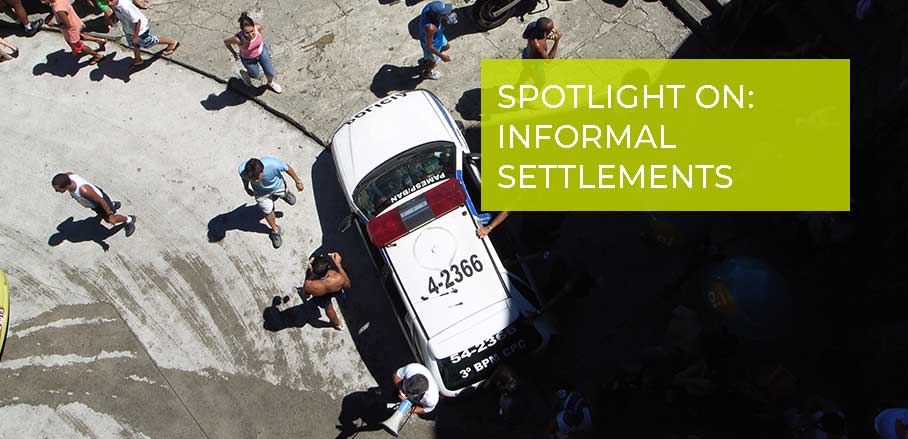Rio de Janeiro’s Favelas: A Status Update from the South
Brazil’s strategies towards its favelas have varied enormously over time. If they are to be successful in improving people’s lives, it is essential that informal settlements are perceived as an integral part of a city, argue Mariana Dias Simpson and Itamar Silva.
When slums are perceived as a threat, or as something to be eradicated, the human right to adequate housing is ignored. And this is the perspective which often (mis)guides public policies that fail, as history has proven many times. In the case of Rio de Janeiro’s favelas, since the first informal settlements appeared on the top of the city’s hills at the end of the 19th century, policies have ranged from passively ignoring or actively harassing residents, to interventions aimed at protecting the rights of slum dwellers and improving their living environments.
Changing Governmental Responses
As such, governmental responses to Rio’s favelas have undergone several non-linear stages: negligence; centralised policies with attempts to eradicate slums whilst mass producing social housing units (1960s/1970s); more progressive policies, based on aided self-help, sites-and-services, and basic slum upgrading (1970s/1980s); austerity measures and neoliberal reforms, leading to the withdraw of the state and of foreign aid in housing and poverty reduction initiatives (1980s/1990s); and comprehensive, in situ slum upgrading and urbanisation (1990s/2000s)(see note below).
Currently, in a context of economic crises, steep rise of extreme poverty, and a populist far-right government in power (where Rio suffers a triple burden, as it lives with such governments in the national, state and local levels), Rio’s slum dwellers are witnessing the total abandonment of all development policies and programmes, against a backdrop of severe police violence in the name of the so-called “war against drugs”.
Since January 2019, when the current governor, Wilson Witzel, took office promising to “aim at the head and…fire!”, a record number of people have been killed by the police in the state of Rio de Janeiro: up until October 2019 , 1,546 people, including six children, were murdered. Every 23 minutes, one poor black young person dies in Brazil, in what is being classified as a genocide of the black youth by social movements.
Is There a Way Out?
The most urgent measure to be taken in Rio de Janeiro’s favelas is for the police to stop shooting. “Stop killing us”, implore people living in favelas. In Brazil’s current situation, shooting to kill, or shooting from the top of a helicopter down to a favela when children are leaving school, has become a policy.
Next, perhaps the way out of “the problem of slums” is to understand that they are not an aberration, but rather a part of existing city structures that needs to be improved. In fact, informal settlements are part of the solution found by over one billion people living in poverty, in a context of “accumulation by dispossession” that has made land unavailable to so many urban citizens in the world.
Slums are not disassociated parts of the city. They are city. They present a different paradigm and show that diverse urban spaces may coexist, provided inequities are overcome and adequate living standards are universalised.
This is possibly a far-fetched dream in Rio de Janeiro’s current reality, but the state needs to pick up from where it left off, and do it better. In situ slum upgrading, as it was for instance developed between the mid-1990s and early 2000s through the Favela-Bairro programme, is, until today, considered the most effective approach to delivering more adequate living standards to informal settlements. Slum upgrading initiatives recognise the right of the poor to live in urban land, whilst also acknowledging that mass produced housing delivered by the state is unsustainable and incapable of responding to the true heterogeneity of low-income families’ demands.
A Tradition of Discontinuation
Overtime though, and as it traditionally tends to happen in Brazil, these policies – that should become public policies rather than a single government’s policy – are discontinued and, as a result, favelas (in constant growth) end up “swallowing” the several hundred millions of dollars invested in urbanisation. A recent example of that is the Medellin-style badly copied cable cars imposed on favelas and that after consuming millions, dislocating hundreds of families and never quite connecting favelas to anything, have stopped operating due to the lack of funds for maintenance.
The relationship between the state and favelas has always been characterised as opportunistic, incomplete, and temporary. And that is something else that needs to stop now.
Note
In situ slum upgrading often consists of some level of land regularisation and improvements to the existing infrastructure up to a satisfactory standard. Typical upgrading projects provide improvements on streets and footpaths, street lighting, drainage, and roads, and often water supply and limited sewerage. Usually, upgrading does not involve home construction, since residents are expected to be able to do that themselves. In this way, in situ slum upgrading acknowledges people’s capacity to produce (or procure) and manage their own shelter and that, given some kind of security’ of tenure to land, households tend to invest their savings, however small, in housing development – “a lengthy and sometimes never-ending process”. The Favela-Bairro programme was labelled a “best practice” by the World Bank and UN-Habitat and is considered “one of the most ambitious and advanced illustrations” of a “new generation of comprehensive slum upgrade policies” . Since the programme was launched in 1994, Rio de Janeiro stayed, for over two decades, in the forefront of in situ slum upgrading and urbanisation initiatives.’
